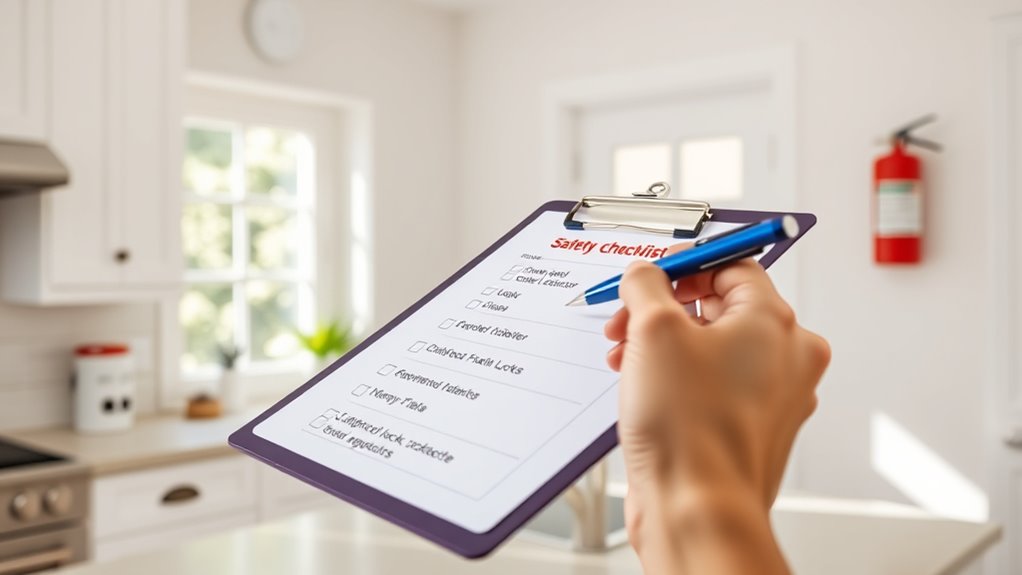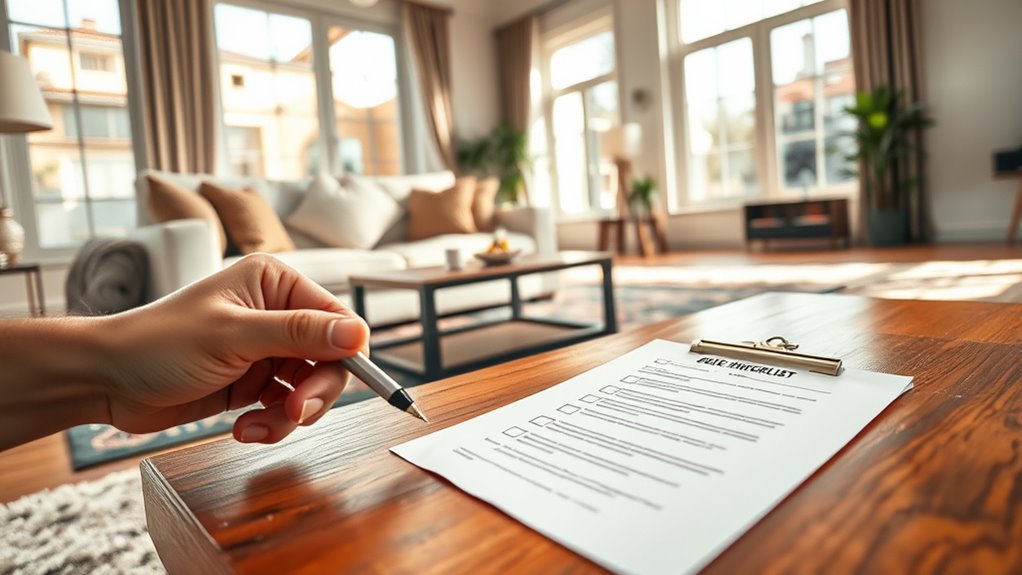Using checklists helps you systematically identify and remove hazards around your home, making it safer for everyone. Regularly inspecting key areas like kitchens, bathrooms, and outdoor spaces ensures hazards such as loose handrails, frayed cords, or clutter are spotted early. By involving household members and documenting your efforts, you foster ongoing safety. Keep your checklist updated and follow through on repairs promptly—this approach makes hazard removal manageable. Discover more ways to keep your home safe and organized by exploring further tips.
Key Takeaways
- Regularly review and update your safety checklist to identify and address new hazards promptly.
- Use the checklist to systematically inspect all home areas, ensuring no hazards are overlooked.
- Involve household members in inspections to increase hazard detection and promote shared responsibility.
- Document hazards found and track repairs or safety improvements for accountability.
- Prioritize addressing urgent hazards immediately and schedule repairs for less critical issues.

Keeping your home safe requires more than just occasional inspections; it demands a systematic approach. One of the most effective ways to achieve this is by using checklists to guide your safety inspections and hazard identification. Checklists serve as a practical tool that keeps you organized and guarantees you don’t overlook critical areas. When you approach your home with a detailed checklist, you’re more likely to spot potential dangers early, reducing the risk of accidents or injuries. Incorporating simple inspection tools like flashlights or smartphone cameras can enhance your ability to detect hazards effectively. Start by creating or obtaining a thorough safety inspection checklist tailored to your home. This list should cover all key areas: the kitchen, bathrooms, bedrooms, living spaces, garage, and outdoor areas. As you go through each section, focus on hazard identification—looking for anything that could pose a risk. This might include loose handrails, frayed electrical cords, slippery floors, or cluttered walkways. The act of systematically checking each item ensures you don’t forget critical safety concerns that could compromise your household’s safety. Using a checklist also helps you prioritize repairs and maintenance. For example, if you identify a broken stair railing during your inspection, you can address it immediately or schedule repairs. This proactive approach prevents accidents before they happen. It also provides documentation of your safety efforts, which can be helpful for insurance purposes or if you ever need to demonstrate that you’re actively maintaining a safe environment. Consistency is key when it comes to hazard identification. Set a regular schedule for safety inspections—monthly, quarterly, or semi-annually—using your checklist each time. Over time, this habit becomes second nature, and you’ll develop a better understanding of your home’s safety needs. As new hazards appear—such as spills, fallen objects, or damaged fixtures—you can add them to your checklist and handle them promptly. Involving your family members in the process can make safety inspections more thorough. Encourage everyone to participate and share their observations. This collective effort increases hazard detection and fosters a safety-conscious mindset within your household. Remember, checklists aren’t just a one-time tool; they’re a dynamic resource that evolves as your home changes or as new safety concerns emerge.
Frequently Asked Questions
How Often Should I Update My Home Hazard Checklist?
You should update your home hazard checklist at least every six months, aligning with your maintenance schedule. Regular hazard assessment frequency helps you spot new dangers and guarantee existing safety measures stay effective. After major home projects or repairs, review the checklist too. Staying proactive keeps your home safe, so make updating a routine part of your maintenance. This way, you’re always aware of potential hazards and can address them promptly.
Can Checklists Prevent All Types of Home Accidents?
Checklists can’t prevent all home accidents, but they considerably improve fire prevention and child safety. By regularly reviewing and updating your checklist, you identify potential hazards and address them proactively. While some risks are unavoidable, staying vigilant with your checklist helps you catch hazards early, reduce accidents, and create a safer environment for everyone. Consistent use of checklists empowers you to maintain a safer home effectively.
What Tools Are Best for Inspecting Hidden Hazards?
You should use tools like safety goggles and inspection mirrors to spot hidden hazards effectively. Safety goggles protect your eyes from dust or debris, while inspection mirrors help you see behind appliances, under sinks, or around tight spaces. These tools make it easier to identify dangers that aren’t immediately visible, ensuring your home is safer. Regularly using them during inspections helps prevent accidents before they happen.
How Do I Prioritize Hazards on My Checklist?
Think of your checklist as a map guiding you through a minefield. You should start with a risk assessment to identify which hazards are most dangerous, then use hazard categorization to rank their urgency. Prioritize hazards that pose immediate threats, like fire or electrical issues, before tackling less urgent ones. This approach guarantees you’re addressing the most critical risks first, making your home safer step by step.
Are Digital Checklists More Effective Than Paper Ones?
Digital tools and checklist apps can be more effective than paper ones because they’re easier to update, organize, and access. You can set reminders, add photos, and track progress in real-time, making it simpler to stay on top of home hazards. Plus, digital checklists are portable and environmentally friendly. If you prefer convenience and versatility, digital checklists help you manage hazards more efficiently than paper ones.
Conclusion
By using checklists regularly, you can effectively identify and eliminate hazards in your home, creating a safer environment for everyone. Did you know that falls are the leading cause of injury at home, especially among older adults? Regular inspections can reduce these risks considerably. Stay proactive by updating your checklist often, and you’ll be surprised how much safer your home becomes. Remember, a little effort today can prevent serious accidents tomorrow.









